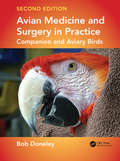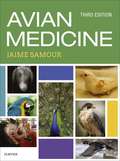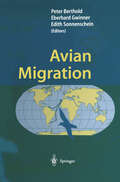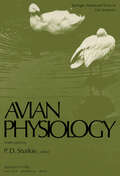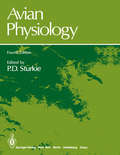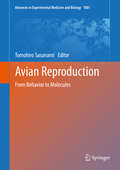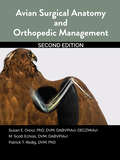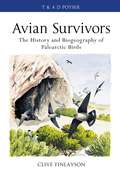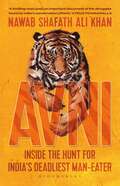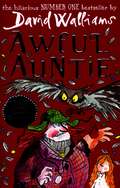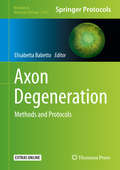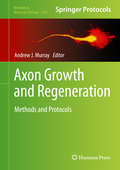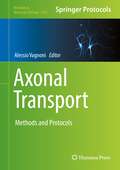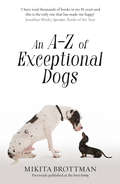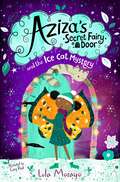- Table View
- List View
Avian Medicine and Surgery in Practice: Companion and Aviary Birds, Second Edition
by Bob DoneleyAvian Medicine and Surgery in Practice is an invaluable quick reference resource for clinicians and a useful study guide for veterinary students. In this practical and beautifully illustrated book, early chapters cover physical examination, advice on interpreting diagnostic tests, and avian anatomy and physiology. Disorders affecting the different body regions and systems make up the majority of the book from the external—skin, feathers, eyes, legs and feet—to the internal including the gastrointestinal tract and the cardiovascular system. Further aspects of avian medicine discussed in the book include behavioural problems, incubation of eggs, paediatrics and surgery. Written by an expert with more than 30 years of clinical experience in avian medicine, the new edition is thoroughly revised with updated diseases, new and expanded clinical techniques, and over 100 new color illustrations. It also adds four important new chapters: Husbandry, Grooming and Nutrition, Diagnostic Imaging, Endoscopy, and Oncology as well as new sections on cardiovascular anatomy and neuroanatomy.
Avian Medicine and Surgery in Practice: Companion and Aviary Birds, Second Edition (Manson Ser.)
by Bob DoneleyAvian Medicine and Surgery in Practice is an invaluable quick reference resource for clinicians and a useful study guide for veterinary students. In this practical and beautifully illustrated book, early chapters cover physical examination, advice on interpreting diagnostic tests, and avian anatomy and physiology. Disorders affecting the different body regions and systems make up the majority of the book from the external—skin, feathers, eyes, legs and feet—to the internal including the gastrointestinal tract and the cardiovascular system. Further aspects of avian medicine discussed in the book include behavioural problems, incubation of eggs, paediatrics and surgery. Written by an expert with more than 30 years of clinical experience in avian medicine, the new edition is thoroughly revised with updated diseases, new and expanded clinical techniques, and over 100 new color illustrations. It also adds four important new chapters: Husbandry, Grooming and Nutrition, Diagnostic Imaging, Endoscopy, and Oncology as well as new sections on cardiovascular anatomy and neuroanatomy.
Avian Medicine - E-Book
by Jaime SamourCombining the in-depth coverage of a text with the practicality of a clinical manual and the visual detail of an atlas, Avian Medicine, 3rd Edition is the complete, all-in-one guide to every aspect of avian care. Written by some of the world's leading authorities in avian medicine, this highly illustrated reference covers a wide variety of avian species — including psittacines, raptors, bustards, parrots, finches, and more. Comprehensive coverage includes issues ranging from the basic aspects of patient management to the most sophisticated diagnostic techniques. Plus, with more illustrations, a wealth of practical advice, and the latest information on cutting-edge treatments and procedures incorporated into this new edition, today’s general clinician will be fully equipped to effectively and confidently care for all birds. Comprehensive coverage of all aspects of clinical management written by leading experts in the field provides readers with a depth and breadth of knowledge on avian medicine and care.Coverage of a wide variety of species — including raptors, bustards, and many others — enables practitioners to treat a greater assortment of patients with more confidence and skill.Bulleted text and tables help present information in an accessible way.More than 900 color images give readers a better picture of disease and how it will be encountered in practice.Appendices bring together wide-ranging data on hematology and blood chemistry reference values, commonly used pharmaceutics and other information relevant to avian practitioners.NEW! New chapter sections, revised references, and updated suggested readings ensure that readers have the most up-to-date information.NEW! New chapter contributors ensure the information in the text reflects the most current techniques and advances.NEW! Expanded content on parrots, finches and fruit-eating birds has been added to the text to make content more relevant to the needs of today’s practitioners. NEW! Thoroughly updated content includes the latest surgical techniques and procedures to keep practitioners on top of the most cutting-edge information in the field.NEW! Additional content and images on MRI have been incorporated throughout the text to complete the coverage of other advanced imaging techniques such as CT scans.
Avian Migration
by Peter Berthold Eberhard Gwinner Edith SonnenscheinP. Berthold and E. Gwinnd Bird migration is an intriguing aspect of the living world - so much so that it has been investigated for as long, and as thoroughly, as almost any other natural phenomenon. Aristotle, who can count as the founder of scientific ornithology, paid very close attention to the migrations of the birds he ob served, but it was not until the reign of Friedrich II, in the first half of the 13th century, that reliable data began to be obtained. From then on, the data base grew rapidly. Systematic studies of bird migration were introduced when the Vogelwarte Rossitten was founded, as the first ornithological biological observation station in the world (see first chapter "In Memory of Vogelwarte Rossitten"). This area later received enormous impetus when ex perimental research on the subject was begun: the large-scale bird-ringing experiment initiated in Rossitten in 1903 by Johannes Thienemann (who was inspired by the pioneering studies of C. C. M. Mortensen), the experiments on photoperiodicity carried out by William Rowan in the 1920s in Canada and retention and release experiments performed by Thienemann in the 1930s in Rossitten, the first experimental study on the orientation of migratory birds. After the Second World War, migration research, while continuing in the previous areas, also expanded into new directions such as radar ornithology, ecophysiology and hormonal control mechanisms, studies of evolution, ge netics, telemetry and others.
Avian Navigation: International Symposium on Avian Navigation (ISAN) held at Tirrenia (Pisa), September 11–14, 1981 (Proceedings in Life Sciences)
by F. Papi H. G. WallraffRight from the start of this century, field observations and the patient ringing of birds have made available a growing mass of data on the breeding and resting areas of migratory species and on the course, period and duration of their seasonal flights. Considered as a whole, this work on migration morphology commands admiration, and when view ed in detail it reveals fascinating insights into the extraordinary naviga tional performances of many bird species, which find their way over enormous distances. Yet only a few dozen physiologists are actively trying to answer the question of how these performances are achieved. Experimental work on migratory birds raises many difficulties, some of them insuperable, so that many researchers carry out their experiments on the homing pigeon, which is constantly motivated by homesickness and ready to display its ability to flyaway home. Many of the problems connected with bird navigation are still un solved, but a rapidly growing body of results is being produced along with a variety of new ideas and approaches. A clear majority of the stu dents of bird navigation met in September 1981 in Tirrenia, a seaside resort on the Tyrrhenian coast, where each of them offered new in sights into his or her recent investigations. Their contributions have been connected in this volume, which provides an up-to-date conspec tus of the stage reached by research in this field.
Avian Navigation: Pigeon Homing as a Paradigm
by Hans G. WallraffHow migratory birds can navigate home from their wintering grounds to their breeding sites over hundreds and thousands of kilometres has been an admired mystery over more than a century. Profound advances towards a solution of this problem have been achieved with a model bird, the homing pigeon. This monograph summarizes our current knowledge about pigeon homing, about the birds' application of a sun compass and a magnetic compass, of a visual topographical map within a familiar area and -- most surprisingly -- of an olfactory map using atmospheric chemosignals as indicators of position in distant unfamiliar areas.
Avian Nutrition: Poultry, Ratite and Tamed Birds
by Nityanand PathakThe scope of book has relevant and important informations on some of the popular tamed birds reared as pet in cages. Among these Parrots and Mayana are companion species capable of learning and limited conversation with members of the house. Bulbul, partridges and pigeon are used for sports. Owners of these birds expect guidance for care and management from the experts of poultry science because so far there appears to be no school on the management of such avian species.Incorporation of these avian species in the book is expected to enrich the knowledge of students and teachers of the Avian and Poultry Science.Note: T& F does not sell or distribute the Hardback in India, Pakistan, Nepal, Bhutan, Bangladesh and Sri Lanka.
Avian Nutrition: Poultry, Ratite and Tamed Birds
by Nityanand PathakThe scope of book has relevant and important informations on some of the popular tamed birds reared as pet in cages. Among these Parrots and Mayana are companion species capable of learning and limited conversation with members of the house. Bulbul, partridges and pigeon are used for sports. Owners of these birds expect guidance for care and management from the experts of poultry science because so far there appears to be no school on the management of such avian species.Incorporation of these avian species in the book is expected to enrich the knowledge of students and teachers of the Avian and Poultry Science.Note: T& F does not sell or distribute the Hardback in India, Pakistan, Nepal, Bhutan, Bangladesh and Sri Lanka.
Avian Physiology (Springer Advanced Texts in Life Sciences)
by P. D. Sturkiegested as acting as transmitters at synapses within point show structural modifications and physiologic 3 the eNS. The evidence for their transmitter roles specialization. Generally this specialization takes the form of the release of some chemical substance, in the bird is reviewed on p. 21. the transmitter, from one neuron (termed the pre synaptic neuron) into the narrow cleft, the synaptic Propagation of Excitation in Neurons gap, between apposed neurons. The postsynaptic membrane exhibits chemosensitivity and responds The axons of motor nerves and the dendrites of to the released transmitter in a characteristic way. sensory nerves are very long and may conduct exci The ability of one neuron to release transmitter tation over a meter or more. Neurons, and also and that of the other neuron to respond to it deter muscle cells, concentrate potassium within them mines the direction of the excitation's passage selves and exclude sodium. The tendency for potas across the synapse and the designation of one sium to leave the cell down its concentration gra membrane as "presynaptic" and the other as "post dient is matched by the concentrating ability of the synaptic. " In the periphery, where neuron apposes sodium pump which also pumps potassium. Be skeletal muscle, specialized regions of the mem cause the cell membrane is permeable to potassium, brane, such as the "endplate," have sometimes de a diffusion potential arises from the unequal con veloped. In smooth muscle, cardiac muscle, and centrations of potassium at either side.
Avian Physiology
by Paul D. SturkieSince the publication of earlier editions, there has been The new edition has a number of new contributors, a considerable increase in research activity ina number who have written on the nervous system, sense organs, of areas, with each succeeding edition including new muscle, endocrines, reproduction, digestion and immu chapters and an expansion of knowledge in older chap nophysiology. Contributors from previous editions ters. have expanded their offerings considerably. The fourth edition contains two new chapters, on The authors are indebted to various investigators, muscle and immunophysiology, the latter an area journals and books for the many illustrations used. Indi where research on Aves has contributed significantly vidual acknowledgement is made in the legends and to our general knowledge of the subject. references. Preface to the 'Third Edition Since the publication of the first and second editions, pathways of birds and mammals. New contributors in there has been a considerable increase of research activ clude M. R. Fedde and T. B. Bolton, who have com ity in avian physiology in a number of areas, including pletely revised and expanded the chapters on respira endocrinology and reproduction, heart and circulation, tion and the nervous system, respectively, and J. G. respiration, temperature regulation, and to a lesser ex Rogers, Jr. , W. J. Mueller, H. Opel, and D. e. Meyer, who have made contributions to Chapters 2,16, 17, tent in some other areas. There appeared in 1972-1974 a four volume treatise and 19, respectively.
Avian Reproduction: From Behavior to Molecules (Advances in Experimental Medicine and Biology #1001)
by Tomohiro SasanamiThis book provides everything from basic knowledge to the recent understandings of avian reproductive physiology, covering many unique aspects. It will inspire avian biologists as well as researchers in varied fields and will offer important steps towards better fertilization success in birds.In spite of the recent remarkable developments in modern technology, a comprehensive understanding of the reproductive mechanisms is still far in the future due to the diverse reproductive tactics in vertebrates. Birds have highly refined reproductive strategies and some of those strategies are unique to birds. However, together with ongoing progress of the genome analysis of birds and the crying need for further increase in meat and egg production, research on avian reproduction is now accelerating and becoming more important.With contributions by leading scientists, the book explains avian primordial germ cells; the sex-determining mechanism; reproductive endocrinology and immunology; sperm, egg, and egg coat; sperm–egg interaction; polyspermic fertilization; seasonal reproduction; social triggers; hormonal and behavioral changes; broodiness; oviductal sperm storage; and biotechnology. This book is recommended for all researchers and students who are interested in birds or reproduction.
Avian Surgical Anatomy And Orthopedic Management, 2nd Edition
by Susan Orosz Scott Echols Patrick RedigAvian Surgical Anatomy: Thoracic and Pelvic Limbs by Orosz, Ensley and Haynes, was published in 1992 and has served as a standard guide for those performing orthopedic surgery on birds. That foundational work is out of print but the need for a concise source of avian surgical anatomy has not changed. Our objective in this edition has been to recapture the musculoskeletal anatomy of the original work and to expand the scope to include comprehensive coverage for the clinical management of common fractures of the long bones of birds, primarily raptors. The procedures described have been honed over two decades of development and refinement by clinicians at the Raptor Center at the University of Minnesota. In addition, we have included details of the vascular anatomy of the limbs, further informing the surgeon and clinician. The class Aves includes thousands of species with countless anatomic variations. Although it is impractical to represent every species, birds commonly encountered in private practice and rehabilitation medicine including poultry, pigeons, parrots and birds of prey were chosen for this book. Details of the vascular anatomy of the limbs were obtained by high resolution digital computed tomography imaging of the appendicular skeleton of several diverse bird species. These images provide a unique comparative aspect that clinicians will find useful in conducting surgical procedures. This new information is intended to help the reader better understand skeletal and vascular anatomy, and thus improve interpretation, reporting of findings, treatment and teaching. This new information is intended to help the reader better understand relationships between musculoskeletal and vascular anatomy, helping the surgeon preserve vasculature during complex orthopedic procedures. It is our hope that it will enrich the interpretation, reporting of findings, development of treatment methods and the teaching of management procedures for orthopedic issues in birds. Since publication of the first edition, numerous advances have been made and published relative to avian orthopedics. In this edition, you will find comprehensive discussion of orthopedic conditions, and clinical management that represents best treatment options and current practices. The title of the book has been changed to reflect inclusion of that information. As our knowledge of avian anatomy, health and disease progresses, so does the need for improved resources that convey this valuable information. Over time the information contained herein will also need to be expanded and updated. The authors humbly submit this work to the veterinary and scientific community for review and scrutiny. We hope that it will contribute to the betterment of avian care.
Avian Surgical Anatomy And Orthopedic Management, 2nd Edition
by Susan Orosz Scott Echols Patrick RedigAvian Surgical Anatomy: Thoracic and Pelvic Limbs by Orosz, Ensley and Haynes, was published in 1992 and has served as a standard guide for those performing orthopedic surgery on birds. That foundational work is out of print but the need for a concise source of avian surgical anatomy has not changed. Our objective in this edition has been to recapture the musculoskeletal anatomy of the original work and to expand the scope to include comprehensive coverage for the clinical management of common fractures of the long bones of birds, primarily raptors. The procedures described have been honed over two decades of development and refinement by clinicians at the Raptor Center at the University of Minnesota. In addition, we have included details of the vascular anatomy of the limbs, further informing the surgeon and clinician. The class Aves includes thousands of species with countless anatomic variations. Although it is impractical to represent every species, birds commonly encountered in private practice and rehabilitation medicine including poultry, pigeons, parrots and birds of prey were chosen for this book. Details of the vascular anatomy of the limbs were obtained by high resolution digital computed tomography imaging of the appendicular skeleton of several diverse bird species. These images provide a unique comparative aspect that clinicians will find useful in conducting surgical procedures. This new information is intended to help the reader better understand skeletal and vascular anatomy, and thus improve interpretation, reporting of findings, treatment and teaching. This new information is intended to help the reader better understand relationships between musculoskeletal and vascular anatomy, helping the surgeon preserve vasculature during complex orthopedic procedures. It is our hope that it will enrich the interpretation, reporting of findings, development of treatment methods and the teaching of management procedures for orthopedic issues in birds. Since publication of the first edition, numerous advances have been made and published relative to avian orthopedics. In this edition, you will find comprehensive discussion of orthopedic conditions, and clinical management that represents best treatment options and current practices. The title of the book has been changed to reflect inclusion of that information. As our knowledge of avian anatomy, health and disease progresses, so does the need for improved resources that convey this valuable information. Over time the information contained herein will also need to be expanded and updated. The authors humbly submit this work to the veterinary and scientific community for review and scrutiny. We hope that it will contribute to the betterment of avian care.
Avian survivors: The History and Biogeography of Palearctic Birds (Poyser Monographs)
by Clive FinlaysonThe impacts of global warming are of concern to all of us. Thepotential responses of birds to climate change have come increasinglyto the fore, and are of particular interest to the ornithologicalcommunity. Are birds sensitive to climate change and how will theyreact to a world of global warming? These are the key issues to beexplored in this book, with particular reference to Western Palearcticbirds. Climate changes that have affected the region in the last two millionyears will be explored, drawing on published data on fossil birds. Amajor part of the book will be devoted to the distribution of WesternPalearctic birds in relation to bioclimate. The final section of thebook looks at migration and the relationship of the Western Palearcticto Africa.
Avni: Inside the Hunt for India's Deadliest Maneater
by Nawab Shafath KhanIn 2018, news that a tigress named Avni had been shot dead in Yavatmal, Maharashtra, went viral online. When the saga played out on national media, the hunters were denounced as ruthless and bloodthirsty. However, there was more to the story.For, the tigress T1, as Avni was originally named, was a man-eater blamed for 13 killings. For over two years, she had spread fear over 150 square kilometres of rural Yavatmal, prompting more than 10,000 people to shut themselves inside their homes at night. Several attempts by the forest department to capture the animal alive had proved futile, and the authorities finally brought in hunters as a last resort.Now, for the first time, Nawab Shafath Ali Khan, the man who led the operation to neutralise T1, reveals the true story behind the biggest man-eating tiger operation in post-independent India. While painting a deeply empathetic portrait of the complexities of human–animal conflicts, Khan also raises important questions about the state of conservation in India.Heart-stopping and eventually tragic, Avni tells the story of a tigress pushed to her limit and of the man tasked with stopping her at all cost.
Awesome Animals: Facts, Stats And Quizzes (EDGE: Stat Attack #1)
by Tracey TurnerStat Attack is irresistible to fact fiends, providing A-Z lists, top tens, etc, and focusing on mind-boggling information about the subjects that really interest them. Fascinating lists are meticulously researched and backed up with supplementary information. The books lend themselves to statistic games and comparisons, and are illustrated in an infographic style.
Awful Auntie (PDF)
by David WalliamsFrom number one bestselling author David Walliams comes another heartfelt but hilarious hoot of an adventureStella Saxby is the sole heir to Saxby Hall. But awful Aunt Alberta and her giant owl will stop at nothing to get it from her. Luckily Stella has a secret and slightly spooky weapon up her sleeve "
Axon Degeneration: Methods and Protocols (Methods in Molecular Biology #2143)
by Elisabetta BabettoThis book is a collection of classical as well as innovative methods used to investigate axon degeneration with a particular focus on addressing the common challenges encountered while performing these procedures. Particular attention is devoted to the study of axon loss in several model organisms, as each poses unique challenges and provides powerful advantages. Written for the highly successful Methods in Molecular Biology series, chapters include introductions to their respective topics, lists of the necessary materials, step-by-step, readily reproducible laboratory protocols, and tips on troubleshooting and avoiding known pitfalls. Authoritative and practical, Axon Degeneration: Methods and Protocols is an ideal guide for facilitating the application and further development of these protocols, which will help the scientific community tackle important questions regarding axon degeneration.Chapters 2, 3, and 20 are available Open Access under a Creative Commons Attribution 4.0 International License via link.springer.com.
Axon Growth and Regeneration: Methods and Protocols (Methods in Molecular Biology #1162)
by Andrew J. MurrayAxon Growth and Regeneration: Methods and Protocols brings together a diverse set of techniques for the study of the mechanisms underlying central nervous system axon growth, consequently providing a resource that will aid in the development of repair strategies. After an introductory section, this detailed volume continues with sections focusing on axon growth in vitro, providing a range of protocols that can be used to examine intracellular signalling pathways, axonal responses to extracellular factors and methods for quantifying outgrowth. The next section provides protocols for inducing experimental injury in vivo as well as some highly promising protocols for promoting regeneration, which segues into the final section highlighting a series of protocols that can be used to monitor the extent of axon regeneration in vivo, ranging from tract tracing to in vivo imaging and functional recovery. As a book in the Methods in Molecular Biology series, chapters contain introductions to their respective topics, lists of the necessary materials and reagents, step-by-step, readily reproducible laboratory protocols and tips on troubleshooting and avoiding known pitfalls.Practical and reliable, Axon Growth and Regeneration: Methods and Protocols aims to serve researchers studying axon regeneration with a significant set of diverse tools, vital for moving on to the next generation of exciting new discoveries in the field.
Axonal Transport: Methods and Protocols (Methods in Molecular Biology #2431)
by Alessio VagnoniThis volume covers a wide range of model systems from invertebrate to humans and in vitro and in vivo. Chapters detail methods on squid, aplysia, xenopus, mouse in vivo, ex vivo, rodent primary neurons, human-derived neurons, zebrafish, drosophila in vivo, primary neurons, c. elegans, and in vitro reconstitution assays.Written in the format of the highly successful Methods in Molecular Biology series, each chapter includes an introduction to the topic, lists necessary materials and reagents, includes tips on troubleshooting and known pitfalls, and step-by-step, readily reproducible protocols. Authoritative and cutting-edge, Axonal Transport: Methods and Protocols aims to further our understanding of the trafficking of cellular components in the nervous system leading to the advancement of basic knowledge that underlines the cell biology of the neuron.The chapters “ Live imaging of RNA Transport and Translation in Xenopus Retinal Axons, Retrograde Axonal Transport of Neurotrophins in Basal Forebrain Cholinergic Neurons, Assessment of Mitochondrial Trafficking as A Surrogate of Fast Axonal Transport in Human Induced Pluripotent Stem Cell Derived Spinal Motor Neurons, Drosophila Primary Neuronal Cultures as a Useful Cellular Model to Study and Image Axonal Transport, and In vitro Reconstitution of Kinesin-Based, Axonal mRNA Transport” are available open access under a Creative Commons Attribution 4.0 International License via link.springer.com
Aye-aye (large print)
by RnibThis page shows an image of a side view of an animal standing on a branch. The animal's head is in the top right of the page and a large bushy tail fills the left of the page. The branch goes diagonally from the centre right to the bottom centre of the page. There is a locator dot shown, which will be at the top left of the page when the image is the correct way up. At the top of its head there are two large rounded ears. Down from these in the middle of its face are two large staring eyes. Down from them is a pink fleshy nose, and then two large rodent-like teeth. The fur of its face is paler than the rest of its body. Down from the face are its front legs. The arm in the right middle of the image (its left) grasps the branch it stands on. Only a clawed thumb is shown, the fingers are hidden on the other side of the branch. Down the page the other hand hangs limply down from the wrist. Note how the middle finger is exceptionally long and thin. The fingers all have very sharp claws. To the left of this is its left back foot. Only two toes are shown, the other toes are hidden on the other side of the branch. The lower big toe's claw is not shown as it is dug into the bark. The second toe has a sharp claw showing. To the left (its right), is the other back leg. It is bent sharply at the knee. In the bottom centre of the image the foot grips the branch with four toes with sharp claws. The big toe is not shown as it is hidden on the other side of the branch. A large bushy tail goes down and left from this leg. It then curves up and right to the top right of the image. The Aye-aye is a rare lemur and a primate. It uses its unusual long thin middle finger to tap a branch and it can then hear with its large ears if there is a grub hidden in the wood. If there is, it extracts it with the specially adapted middle finger for food. Its head and body is about 40 cm long and its tail is longer than its body.
Aye-aye (UEB contracted)
by RnibThis page shows an image of a side view of an animal standing on a branch. The animal's head is in the top right of the page and a large bushy tail fills the left of the page. The branch goes diagonally from the centre right to the bottom centre of the page. There is a locator dot shown, which will be at the top left of the page when the image is the correct way up. At the top of its head there are two large rounded ears. Down from these in the middle of its face are two large staring eyes. Down from them is a pink fleshy nose, and then two large rodent-like teeth. The fur of its face is paler than the rest of its body. Down from the face are its front legs. The arm in the right middle of the image (its left) grasps the branch it stands on. Only a clawed thumb is shown, the fingers are hidden on the other side of the branch. Down the page the other hand hangs limply down from the wrist. Note how the middle finger is exceptionally long and thin. The fingers all have very sharp claws. To the left of this is its left back foot. Only two toes are shown, the other toes are hidden on the other side of the branch. The lower big toe's claw is not shown as it is dug into the bark. The second toe has a sharp claw showing. To the left (its right), is the other back leg. It is bent sharply at the knee. In the bottom centre of the image the foot grips the branch with four toes with sharp claws. The big toe is not shown as it is hidden on the other side of the branch. A large bushy tail goes down and left from this leg. It then curves up and right to the top right of the image. The Aye-aye is a rare lemur and a primate. It uses its unusual long thin middle finger to tap a branch and it can then hear with its large ears if there is a grub hidden in the wood. If there is, it extracts it with the specially adapted middle finger for food. Its head and body is about 40 cm long and its tail is longer than its body.
Aye-aye (UEB uncontracted)
by RnibThis page shows an image of a side view of an animal standing on a branch. The animal's head is in the top right of the page and a large bushy tail fills the left of the page. The branch goes diagonally from the centre right to the bottom centre of the page. There is a locator dot shown, which will be at the top left of the page when the image is the correct way up. At the top of its head there are two large rounded ears. Down from these in the middle of its face are two large staring eyes. Down from them is a pink fleshy nose, and then two large rodent-like teeth. The fur of its face is paler than the rest of its body. Down from the face are its front legs. The arm in the right middle of the image (its left) grasps the branch it stands on. Only a clawed thumb is shown, the fingers are hidden on the other side of the branch. Down the page the other hand hangs limply down from the wrist. Note how the middle finger is exceptionally long and thin. The fingers all have very sharp claws. To the left of this is its left back foot. Only two toes are shown, the other toes are hidden on the other side of the branch. The lower big toe's claw is not shown as it is dug into the bark. The second toe has a sharp claw showing. To the left (its right), is the other back leg. It is bent sharply at the knee. In the bottom centre of the image the foot grips the branch with four toes with sharp claws. The big toe is not shown as it is hidden on the other side of the branch. A large bushy tail goes down and left from this leg. It then curves up and right to the top right of the image. The Aye-aye is a rare lemur and a primate. It uses its unusual long thin middle finger to tap a branch and it can then hear with its large ears if there is a grub hidden in the wood. If there is, it extracts it with the specially adapted middle finger for food. Its head and body is about 40 cm long and its tail is longer than its body.
An A–Z of Exceptional Dogs
by Mikita BrottmanPreviously published as The Great Grisby ‘You cannot help but fall in love with Grisby’ Jeffrey Masson In this charming bestiary of exceptional dogs, Mikita Brottman reflects on the role dogs play in our world, explored through her relationship with her dog Grisby and the dogs of great writers and artists from literature, lore, and life.
Aziza's Secret Fairy Door and the Ice Cat Mystery (Aziza's Secret Fairy Door #2)
by Lola MorayoAziza's Secret Fairy Door and the Ice Cat Mystery is the second title in a fun and inclusive, young magical adventure series for readers of 6-8 from Lola Morayo. This magical story is inspired by fairies and magical creatures from world mythology and is gorgeously illustrated in black and white throughout by Cory Reid.Aziza can't wait for the Holidays when the flat is filled with pretty tinsel and delicious smells. It's warm and cosy in Aziza's bedroom, so when she notices that her Secret Fairy Door is covered in ice and frost, it's a sure sign that she's about to go on a new adventure. Aziza crosses the threshold and finds Shimmerton covered in ice and snow, even though it is supposed to be high summer there. Everything is muddled up – even the Yule Lads have been spotted causing mischief! Ccoa the Ice Cat has gone missing and Aziza, her fairy friends and even the naughty Gigglers, must team up if they are to track him down and put everything right again.Packed with mischief, friendship and magic, Aziza is perfect for fans of Isadora Moon.
